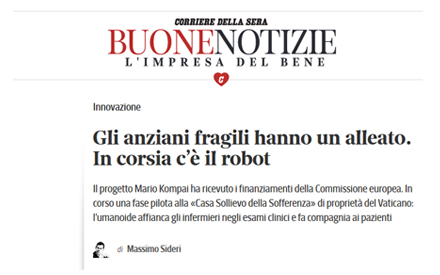With the exit of Robosoft, the consortium was in part left without an important aspect of our exploitation strategy – the manufacturer of the robotic platforms. Collaboration is still possible with Kompai Robotics. To take control of the scenario and to not risk losing momentum, opportunities and networks established by the project, R2M in parallel to the project activities invested in and committed to a distributorship with Zora Robotics for the sale, distribution and support of Zorabots in Italy. Since R2M is leading the exploitation activities of the MARIO project this partnership will create an additional exploitation route for some of the MARIO foreground such as the MARIO apps in Italy.
Zora Robotics has developed the world leading application development framework and user interface on top of Softbank’s Nao and Pepper platforms. More than 20,000 people use the more than 70 applications to make their robots useful and fun. With Zora, you don’t need an ICT department and you don’t need to be a robotics expert to expand the Softbank’s robotic systems functionalities. It is like having windows installed on a PC (or other operating system). Without it – the PC can be hard to use for non-computer experts. With it, you can use the PC to change the world. With Zorabots you get the basic NAO system, the application development framework and a library of 70+ applications to work out, be productive, have fun etc. Zorabots have been successfully deployed as assistant to retail, hospitality, healthcare and elder care.
 On September 19th Mario was featured on the first issue of “Le Buone Notizie” (“The Good News”), the new weekly insert of Corriere della Sera about social issues.
On September 19th Mario was featured on the first issue of “Le Buone Notizie” (“The Good News”), the new weekly insert of Corriere della Sera about social issues.
Corriere della Sera is the largest circulation newspaper in Italy, with 250,000 copies being sold and around 3 million readers. The full page article was written by Massimo Sideri, columnist of Corriere and newly appointed director of Corriere Innovazione, i.e. the weekly Corriere’s insert on technology: it covers all relevant aspects of Mario, focusing on the consortium composition and the relevance of assistive robots for the interaction with elderly patients with dementia in hospitals and home care settings. Following the article, IRCCS Casa Sollievo della Sofferenza and its Mario robot were featured on “La Vita in Diretta” (the afternoon talk show on RAI 1, the main Italian TV channel).
 The recent report titled “Application of novel industrial scale robot automation in elderly care” from VTT Finland raised a lot of discussions in the robotics for elderly care domain. MARIO being an EU funded project on robots for care of persons with dementia is obviously one of the interested stakeholders that should pay attention to it and take its conclusions into account. In our next newsletter we will accommodate an interview with Dr Marketta Niemelä Project Manager of the ROSE project and Dr Hannu Lehtinen, author of the aforementioned report that covers a lot of interesting suvjects on the future of robotics. As an appetizer we are publishing today a short extract of the full interview.
The recent report titled “Application of novel industrial scale robot automation in elderly care” from VTT Finland raised a lot of discussions in the robotics for elderly care domain. MARIO being an EU funded project on robots for care of persons with dementia is obviously one of the interested stakeholders that should pay attention to it and take its conclusions into account. In our next newsletter we will accommodate an interview with Dr Marketta Niemelä Project Manager of the ROSE project and Dr Hannu Lehtinen, author of the aforementioned report that covers a lot of interesting suvjects on the future of robotics. As an appetizer we are publishing today a short extract of the full interview.
Question: As children, did you have any special affection for robots? Did they inspire you? Or you were ‘cool’ and distantiated from all the emotional aspects of humanoid robots?
- Marketta: I did not fancy robots as a child in any special way. But I recall that when I was around 10 years old, my father brought a computer from his workplace to home for us kids to play games - it was the first computer I ever saw. I was totally fascinated about it, not just playing but understanding how it works. Much later I studied computer science and psychology and finally ended up to study robots. Now I have a daughter who is 10 years old, and she asks me to bring a robot from work to home, so she can play with it…
- Hannu: The humanoid robot Little Helper of Gyro Gearloose (a Disney character) attracted me to robotics well before 1975 – the year to plan my education. Amazing on-line control was done at those days at the Helsinki University of Technology – now named Aalto University - via cassette reader interface of an ASEA robot. That got me to mainly focus my studies on robotics. Humanoid robots are typically not economically feasible, because they are competing with us – humans. We have sensing, intelligence and motion skills that are very expensive to duplicate in robots.
We are all aware that Europe has the highest prevalence of dementia in the world: seven million people are currently affected and this is projected to increase to 13.4 million by 2050.
In the management of the health and care of dementia patients, the caregivers play a pivotal role, but although caregiving may be rewarding, providing care to a family member is stressful. In light of this, the robotic solutions can support dementia patients and their caregivers. So, it becomes essential to determine specific needs and preferences of formal and informal caregivers for improving the assistance of dementia patients by a robotic solution, and guiding the technological development of the same robot. In this European project, caregivers of 139 dementia patients were interviewed in National University of Ireland (NUIG), in the Geriatrics Unit of IRCCS “Casa Sollievo della Sofferenza”-Italy and in Alzheimer Association Bari-Italy (AAB). A six minute video on technological devices and functions of MARIO was showed, and all caregivers fulfilled a 43-item questionnaire that explored four areas: A) Acceptability, B) Functionality, C) Support devices, and D) Impact.